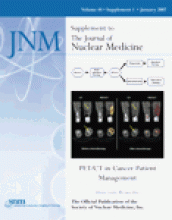Two years ago, The Journal of Nuclear Medicine published a supplement that introduced to a large readership the technical background of in-line PET/CT (1,2) and software image fusion (3,4). Also discussed were imaging protocols (5,6) that were applied to the first clinical studies with PET/CT for evaluating cancer patients (7–10) and for planning radiation therapy (11).
Since Townsend and Beyer (12) introduced the concept of PET/CT imaging only 6 years ago, state-of-the-art CT imaging technology has been combined with high-end PET systems. Acceptance and clinical use of these hybrid systems have been widespread. In 2005 alone, more than 500 PET/CT units were sold. According to industry estimates, more than 1,700 PET and PET/CT units were currently in use and more than 1,300,000 patients underwent whole-body PET/CT and PET studies in the United States in 2005. Supported by a large body of evidence documenting the superior diagnostic and logistic performance of PET/CT over PET or CT alone for diagnosing, staging, restaging, and treatment monitoring of most major types of cancer, the proliferation of PET/CT has prompted an ever-increasing clinical use of cancer glucose metabolism imaging.
Despite the impressive growth of PET/CT, there is no consensus on the optimum clinical use of PET/CT and its implementation into patient management. It was this absence of a consensus that prompted the development of this supplement to The Journal of Nuclear Medicine. It is clear that efficacious use of PET/CT requires close collaboration between physicians from different clinical specialties and subspecialties. Rather than being asked to suggest practice guidelines, the contributors to this supplement were asked to explore and describe how PET/CT imaging is used in their own clinical practice. Oncologists, internists, and general practitioners, as well as radiologists and nuclear medicine physicians, are frequently overwhelmed by the need to select—from among the different imaging modalities—the one that best serves the needs of their patients. Selecting the “best” PET/CT protocol for a given clinical problem adds another layer of complexity for referring physicians and practicing imaging specialists, who need to avoid redundancies in diagnostic tests that frequently involve radiation. Contributors to this supplement were asked to provide a conceptual framework for the clinical integration of PET/CT in which imaging specialists join forces with oncologists or epidemiologists to provide a subjective but realistic and balanced view of the most efficacious use of PET/CT.
Evidence up to September 2006 in support of the clinical integration of PET/CT is summarized by Czernin et al. (13) in this supplement. Schöder and Gönen (14) critically review whether and how PET/CT could be used for cancer screening, a topic that has created considerable controversy. The authors conclude that the clinical and statistical relevance of occasionally detected cancers is likely too low to justify populationwide screening efforts with these 2 imaging modalities. The integration of PET and PET/CT into the risk-adapted therapy of lymphoma is presented by Kasamon et al. (15), who demonstrated that PET/CT improves the accuracy of staging and response assessment over that with CT alone. Israel and Kuten (16) propose that 18F-FDG PET/CT can make a difference in the diagnosis and care of patients with cancer recurrence, whereas Weber and Figlin (17) discuss whether and how PET/CT imaging can improve the treatment monitoring of cancer patients. Kuehl et al. (18) suggest that PET/CT cannot replace all separate CT studies and that specific CT protocols are still needed in the management of some cancer patients. The integration of PET/CT into the management of head and neck and thyroid carcinoma is presented by Quon et al (19), who also propose a management algorithm that includes PET/CT. Finally, the potential role of PET/CT in improving the planning of radiation therapy is discussed by Grégoire et al (20).
This supplement does not intend to provide practice guidelines. Rather, it reflects the authors' experience and approach to the implementation of PET/CT into clinical practice. It is hoped that the supplement will be a useful resource for physicians in best utilizing the benefits of PET/CT for their patients and, at the same time, will stimulate the future development of practice guidelines.







